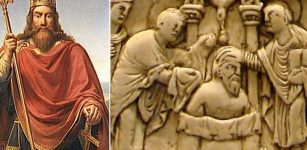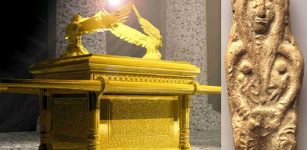Nammu: Sumerian Goddess Who Got The Idea To Create Mankind In The Image Of Gods
A. Sutherland - AncientPages.com - In Sumerian mythology, Nammu (Namma) was the "primeval sea" - the ultimate origin of everything.
The goddess Nammu gave birth to the heavens and the earth and life to the first couple of gods.
More exactly, she gave birth to the male sky god, An, and the female earth goddess, Ki, whose union, in turn, produced the god Enlil (Air), source of the ordered universe, responsible for cattle, agriculture tools, vegetation, and the arts of civilization. Man was created to serve the gods and provide them with nourishment.
Nammu /Namma), a primeval goddess, who gave birth to An (heaven) and Ki (earth) and the first gods; Right: Enki god of the god of wisdom, creator, protector of humanity and the patron of craftsmen and artisans.
Nammu represented the oldest generation of Mesopotamia’s deities and was the mother of the god Enki (Ea), the Sumerian water god of Eridu, located in the southern wetlands of what is today Iraq. Enki was also the god of wisdom, creator, protector of humanity, and patron of craftsmen and artisans.
Not much is known about the Eridu goddess, Nammu, but she may have been a much more important prehistoric deity in the times before her son Enki took over most of her tasks.
Enki’s birth as the son of the goddess Nammu is attested in the Neo-Sumerian mythological text entitled “Enki and Ninmah.” It is said that Nammu got the idea to create mankind in the image of gods; however, to do this, she had to consult her son Enki, who gave his mother instructions on how to fashion man.
Samuel Noah Kramer, Assyriologist and a world-renowned expert in Sumerian history, writes that the poem begins with what may be a description of the difficulties of the gods in procuring their bread, especially after the female deities had come into being.
The gods complain, but Enki, the water god— as the Sumerian god of wisdom who is expected to come to their aid—is lying asleep in the deep and fails to hear them.
Enki gives the matter thought, leads forth the host of "good and princely fashioners," and says to his mother, Nammu, the primeval sea:
"O my mother, the creature whose name you uttered, it exists,
Bind upon it the image of the gods;
Mix the heart of the clay that is over the abyss,
The good and princely fashioners will thicken the clay..."
In the Sumerian poem “Enki and Ninmah,” Nammu’s role in Mesopotamian cosmology is particularly emphasized. Still later, however, in other texts such as the Akkadian ones, Nammu lost her importance, being only mentioned infrequently. In a later myth of Sumer, she became known as Tiamat.
The Mesopotamian scribes depicted and described Nammu as a goddess without a husband, the self-procreating womb of the universe. No male divine deity in connection with Nammu was ever mentioned in ancient Mesopotamian sources.
This led to the belief that the first cosmic production was asexual, according to the Sumerian creation myth.
Very little historical information can attest to cult places for the goddess Nammu, representing the oldest generation of Mesopotamian deities.
Her latest reference dates to the Neo-Babylonian period, when King Nabonidus (556 until 539 BC), the last king of Babylonia, mentioned Nammu’s shrine as part of the Esagil, known as the temple constructed to honor Marduk, the protector god of Babylon and located south of the ziggurat Etemenanki.
Updated on January 26, 2024
Written by – A. Sutherland - AncientPages.com Senior Staff Writer
Copyright © AncientPages.com All rights reserved. This material may not be published, broadcast, rewritten or redistributed in whole or part without the express written permission of AncientPages.com
Expand for referencesReferences:
Kramer N. Samuel, History Begins At Sumer
Leick G. A dictionary of ancient Near Eastern mythology
More From Ancient Pages
-
 Goddess Huitaca – Moon Goddess Of Intoxication, Joyful Life And Unlimited Pleasures In Muisca Mythology
Featured Stories | Mar 14, 2021
Goddess Huitaca – Moon Goddess Of Intoxication, Joyful Life And Unlimited Pleasures In Muisca Mythology
Featured Stories | Mar 14, 2021 -
 Unseen 3,000-Year-Old Inscription On Biblical-Era Piece Of Pottery Deciphered By Researchers
Archaeology | Jun 21, 2017
Unseen 3,000-Year-Old Inscription On Biblical-Era Piece Of Pottery Deciphered By Researchers
Archaeology | Jun 21, 2017 -
 What Was Lex Salica?
Ancient History Facts | Dec 13, 2017
What Was Lex Salica?
Ancient History Facts | Dec 13, 2017 -
 Ancient Maya Ballcourts And Evidence Of Ceremonial Plant Species Offerings
Ancient Traditions And Customs | Apr 29, 2024
Ancient Maya Ballcourts And Evidence Of Ceremonial Plant Species Offerings
Ancient Traditions And Customs | Apr 29, 2024 -
 Mystery Of The Anglo-Saxon Harpole Burial Continues – New Clues
Archaeology | Dec 14, 2023
Mystery Of The Anglo-Saxon Harpole Burial Continues – New Clues
Archaeology | Dec 14, 2023 -
 Hamingja – Norse Guardian Spirit Bringing Good Luck From Generation To Generation
Myths & Legends | May 20, 2024
Hamingja – Norse Guardian Spirit Bringing Good Luck From Generation To Generation
Myths & Legends | May 20, 2024 -
 2,000-Year Old Engraved Kurdistan Tablet Referring To A Hellenistic Ruler Demetrius – Analyzed
Archaeology | Dec 14, 2020
2,000-Year Old Engraved Kurdistan Tablet Referring To A Hellenistic Ruler Demetrius – Analyzed
Archaeology | Dec 14, 2020 -
 Intriguing Discovery Could Offer Proof Of The Tabernacle – Has The Dwelling Place Of God Been Located?
Archaeology | Nov 9, 2013
Intriguing Discovery Could Offer Proof Of The Tabernacle – Has The Dwelling Place Of God Been Located?
Archaeology | Nov 9, 2013 -
 Ancient City Of Carchemish Will Soon Be Ready To Show Its Historical Treasures
Archaeology | Jun 20, 2019
Ancient City Of Carchemish Will Soon Be Ready To Show Its Historical Treasures
Archaeology | Jun 20, 2019 -
 Was A Statue Of Asherah Hidden In The Ark Of The Covenant?
Artifacts | Dec 26, 2017
Was A Statue Of Asherah Hidden In The Ark Of The Covenant?
Artifacts | Dec 26, 2017 -
 Famous Bayeux Tapestry May Solve The Planet Nine Mystery
Archaeoastronomy | May 5, 2018
Famous Bayeux Tapestry May Solve The Planet Nine Mystery
Archaeoastronomy | May 5, 2018 -
 Herostratic Fame Relates To Herostratus Who Burned The Beautiful Temple Of Artemis To Become Famous
Ancient History Facts | Jan 6, 2017
Herostratic Fame Relates To Herostratus Who Burned The Beautiful Temple Of Artemis To Become Famous
Ancient History Facts | Jan 6, 2017 -
 Humans’ Oldest Jawed Ancestor Is A 439-Million-Year-Old Spiky Shark – Surprising Discovery Shows
Archaeology | Sep 29, 2022
Humans’ Oldest Jawed Ancestor Is A 439-Million-Year-Old Spiky Shark – Surprising Discovery Shows
Archaeology | Sep 29, 2022 -
 Dangerous Magnetic Anomaly And Unexplained Events In Mysterious And Dark Valley Trouble Scientists – Why Must The Stone Gate Not Be Crossed?
Featured Stories | Nov 7, 2024
Dangerous Magnetic Anomaly And Unexplained Events In Mysterious And Dark Valley Trouble Scientists – Why Must The Stone Gate Not Be Crossed?
Featured Stories | Nov 7, 2024 -
 Medieval Criminals Could Avoid Persecution By Claiming Sanctuary In Churches
Ancient History Facts | Mar 3, 2017
Medieval Criminals Could Avoid Persecution By Claiming Sanctuary In Churches
Ancient History Facts | Mar 3, 2017 -
 Yayoi People (Korea) Interbred With Jomon People (Japan) Giving Birth To Ancestral Group Of Modern Japanese People
News | Oct 17, 2024
Yayoi People (Korea) Interbred With Jomon People (Japan) Giving Birth To Ancestral Group Of Modern Japanese People
News | Oct 17, 2024 -
 Magnificent Ancient Egyptian Gold And Soapstone Jewelry Discovered At Tell El-Amarna Necropolis
Archaeology | Dec 18, 2022
Magnificent Ancient Egyptian Gold And Soapstone Jewelry Discovered At Tell El-Amarna Necropolis
Archaeology | Dec 18, 2022 -
 Evidence Scots And Irish Settled Iceland A Century Before The Vikings?
Featured Stories | Jan 7, 2023
Evidence Scots And Irish Settled Iceland A Century Before The Vikings?
Featured Stories | Jan 7, 2023 -
 Ancient Egyptian Monuments Threatened By Climate Change Restored By Oriental Institute
News | Mar 9, 2023
Ancient Egyptian Monuments Threatened By Climate Change Restored By Oriental Institute
News | Mar 9, 2023 -
 Ancient Ruins Of Nero’s Theater Discovered Under Garden Near Vatican
Archaeology | Jul 27, 2023
Ancient Ruins Of Nero’s Theater Discovered Under Garden Near Vatican
Archaeology | Jul 27, 2023

